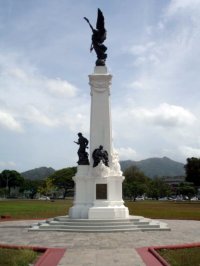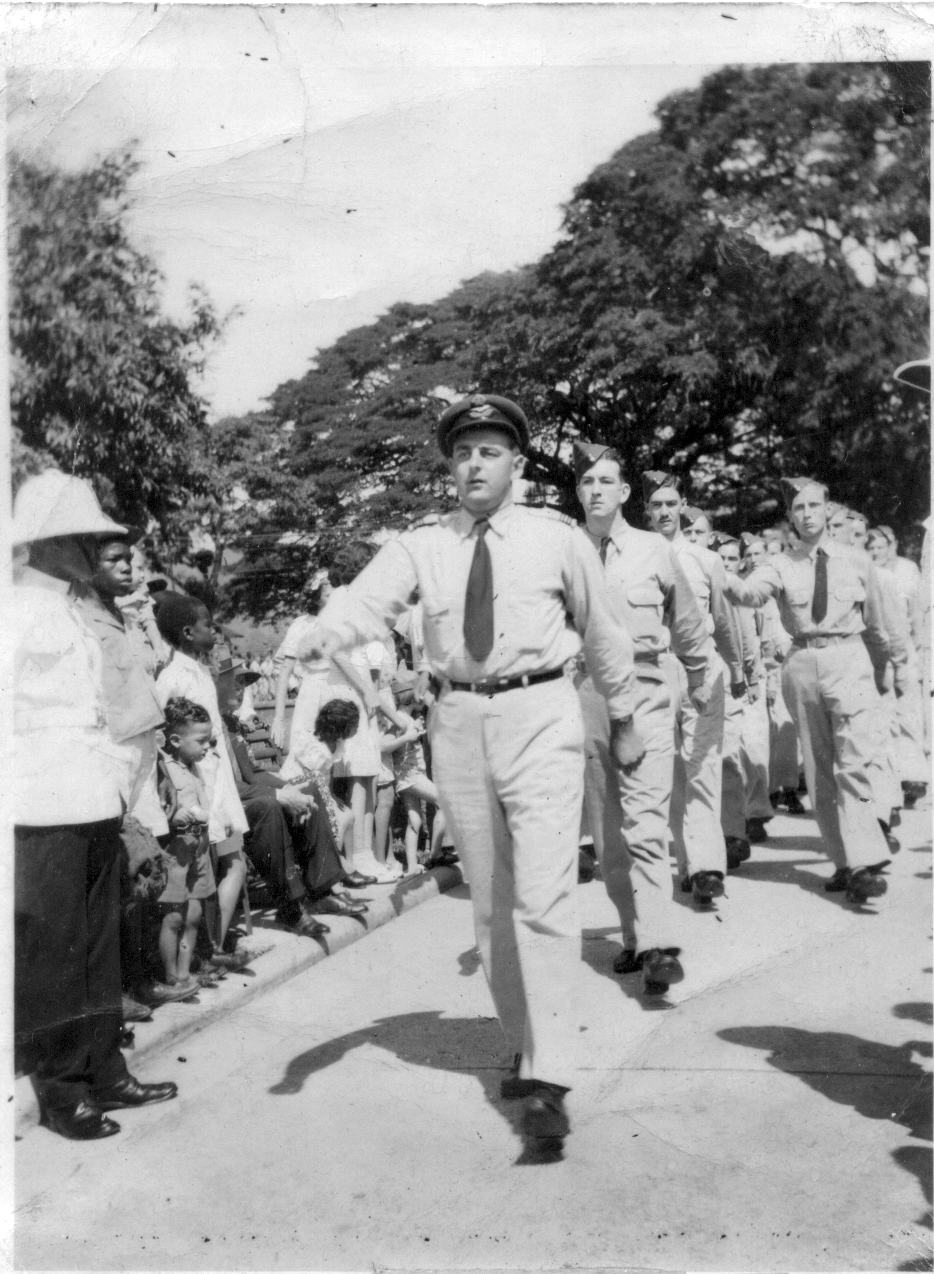

Memorial Park
Port of Spain
Trinidad
VICTORY THROUGH SACRIFICE
CONCEPT
At a Public Meeting held on August 4th, 1916 at The Princes Building, chaired by His Worship The Mayor, Mr. Enrique Prada and which included the then Governor Sir John R Chancellor, R.E., K.C.M.G., D.S.O. (Jun 1916 – Dec 1921), the following Resolution was moved:-
“RESOLVED:- That on this 2nd Anniversary of the declaration of a righteous war, this meeting of the Citizens of Port of Spain records its inflexible determination to continue to a victorious end the struggle in maintenance of those ideals of liberty and justice which are the common and sacred cause of the Allies."
Though no mention is made, It was presumably at this meeting that the idea of some form of War Memorial for the Colony was mooted, for at the City Council Meeting of August 31, 1916, the Council adopted the motion
“That in the opinion of this Council it is desirable that a memorial recording the part taken by the Colony in the Great War be erected in the City of Port of Spain; and that a Committee of this Council be appointed to consider and report what steps should be taken to give effect to this resolution”.
This War Memorial Committee met on September 7th, and made a few recommendations. On the whole however, it was felt that the matter should be deferred until War’s end. Here matters stood until on December 7, 1918, the War Memorial Committee met and re-affirmed the 1916 City Council Resolution and planning proceeded steadily, if not always smoothly.
SITE
The first public meeting was held on 27 January 1919 and the decision was taken that the Memorial should be placed in the centre of the open space at the junction of Broadway, Frederick Street and Marine Square. Almost immediately however objections to this site (on financial & aesthetic grounds) were raised and continued, until on January 24th, 1921, The Executive Committee decided that the cost to relocate the existing tramway lines were too prohibitive ($25,000) and instead the new site should be shifted to the eastern side of the central open space at the head of Broadway, on the side of what was known as the cart stand.
Objections to the Marine Square site as a whole however continued afresh and with influential sectors of society making representations on behalf of The Fallen, Returned Soldiers and The Trinidad Working Men’s Association for a worthier position for the Colony’s War Memorial, a new site variously called the Little Savannah, the Small Savannah and The Holy Name Savannah, located south of the Queen’s Park Savannah was considered.
Assuming Office in January 1922, His Excellency, The Governor, Brigadier-General Sir Samuel Herbert Wilson, R.E., K.C.M.G., C.B. (Jan 1922 – Nov 1924), settled the matter when he indicated his willingness to transfer title for the Little Savannah to the Port of Spain Corporation for the erection of the War Memorial.
On November 30th, 1922, a public representative meeting, called to re-consider the site of the Memorial, decided finally on the Little Savannah site and on June 28th, 1923, title of the Little Savannah was conveyed to the Port of Spain Corporation on the condition that it be used for the erection of the War Memorial and maintained as a Memorial Park.
DESIGN
In 1919 whilst on holiday in England, the then Governor, His Excellency Lt. Col. Sir John R Chancellor, R.E., K.C.M.G., D.S.O., contacted the well known sculptor Mr. L F Roslyn RBS, and who with the aid of drawings and photographs of the proposed site (at Marine Square), submitted several designs of the Memorial for consideration. These designs were exhibited for public criticism at Maillard’s store on Frederick Street and the present design was selected on 21st January 1921. The concept of Roslyn was the theme “Victory Through Sacrifice”. It was intended that the Memorial itself would be placed on top of an arch through which the tram-lines would pass.
FUNDING
The majority of funding for the Memorial came from the public treasury, with some $32,000 coming from the War Stamp Tax fund. Approximately $5,000 was raised from public subscription. As of writing, details of the War Memorial Fund Accounts & Minutes have not yet been located so the actual cost of the Cenotaph is still uncertain, but is probably less than $50,000 based on the figures so far uncovered.
The cost of the foundation and the erection of the Memorial was borne by the War Memorial Fund but the cost for the laying of the concrete pathways and other works around the Memorial was borne by the City Corporation.
LAYING OF FOUNDATION STONE
On 1st May 1924, His Excellency ,The Governor, Brigadier-General Sir Samuel Herbert Wilson, RE, KCMG, KBE, CB, with the completion of the foundation work, in a simple ceremony, embedded in the base and enclosed in a sealed bottle, documents relating to the history of the Memorial as well as copies of local newspapers and current coins of the realm. Work on the Memorial then continued and it was completed in time for the formal unveiling & dedication date of June 28, 1924.
UNVEILING & DEDICATION CEREMONY
Synchronising with the 5th Anniversary of the signing of the Treaty of Versailles, the formal unveiling ceremony took place on June 28th, 1924, commencing at 3.30 pm. There was a full turn out from all sectors of society. The Guard of Honour was supplied by the visiting ship, HMS Ormonde (which was completing a survey of the harbour). Sentries for the four corners of the Memorial were as follows:
North West: Able Seaman W G Bronne representing the Royal Navy
South West: Lance Corporal Richard Turpin DCM., 1st Batt. B.W.I. Regiment, representing the B.W.I. Regiment
South East: Private Alfred H Mendes MM late 1st Rifle Brigade representing the Merchants and Planters’ Contingents
North East: Corporal Osborne DCM The Trinidad Constabulary late Machine Gun Sergeant West India Regiment representing all others who fought in the Great War.
DESCRIPTION
The following description is taken wholly from the Port of Spain Gazette:
“The Memorial is of Portland stone and bronze, with a set of four granite steps around the base constructed on a solid circular concrete foundation about eighteen feet across. Standing squarely on the granite steps is the massive base of the column, let into which are the bronze panels engraved with the names of the fallen, some 168 in number. Rising immediately above this are three emblematic groups of statuary, - one in front and one on either side. The front represents Courage, - the figure of a soldier armed with a rifle, standing guard over and defending a dying comrade who lies on the ground at his feet. The side groups are the prows of ships emblematic of the part taken in the war by the Royal Navy and the Mercantile Marine, and on each is seated a female figure – the one on the South in a pensive attitude reading the scroll of Fame, the other on the North, bearing a laurel wreath, emblematic of the tender care of the sick and fallen. To the rear of the base is a group of trophies massed together, and surmounted by the arms of the Colony and the Royal Crown, supported by the flags of the Empire, with a trident in the rear. Rising clear out of this base is the beautiful tall column of pure white Portland stone to a height of nearly forty two feet, surmounted by a carved stone frieze, with lions’ heads at the four corners. The whole is surmounted by a winged figure of Victory, cast in bronze, standing on a globe commemorative of the world wide conflict, and bearing in one outstretched hand the wreath of sacrifice, and in the other the victor’s palm.
It faces West, and stands in the centre of the Park, almost in direct line with the Holy Name Chapel. The main entrance to the Park is centrally situated on the West and leads to a concrete path, about five feet wide, on either side of which, as around the circular concrete base of the Memorial is a young cultivation of lovely palms. Inscribed on the Western or frontal panel in golden letters about three inches long are the words:-
IN HONOUR OF
ALL WHO SERVED
IN MEMORY OF
THOSE WHO FELL
The names of those who died are inscribed in raised letters, on bronze plaques – the B.W.I.R. men occupying the largest plaque on the eastern side and others who served on the North and South sides. Its erection was undertaken by Mr T H Scott, M.I.C.E., City Engineer.”
THE FALLEN
There are in fact 180 names inscribed on the Cenotaph (81 Regular Army, 7 Air Force, 9 Navy, 83 BWIR), all dating from the First World War period. They served in various Units of the British Armed Forces – Royal Navy, Army, Royal Flying Corps/Royal Air Force and British West India Regiment – as well as the Armed Forces of Canada and France, and in one instance, the US of America.
The names of those killed in the Merchant Marine are not mentioned except in error. Firemen C J L McDonald and E N Williams are recorded on the Cenotaph as serving in the Royal Navy, when in fact the Commonwealth War Graves Commission (CWGC) record their service as Merchant Marine, and their names are therefore included in the Merchant Marine List and NOT the Naval List.
It is uncertain what exactly was the criteria for inclusion on the Roll of Honour, but the Franklin Yearbook of 1919 perhaps give a clue, as in the section entitled “Trinidad’s Roll of Honour”, they intriguingly state: “ Comprising those who were native born as well as those who had made Trinidad their home, left in response to the Mother Country’s Call for men, and surrendered their lives for King and Empire in the greatest war the world has ever seen.”
Further research has found 28 additional names associated with Trinidad & Tobago (20 Merchant Marine, 7 Army, 1 Navy) and who are not listed on the Cenotaph. There may well be others.
WORLD WAR 2
After the second World War, the Memorial was re-dedicated and the date of the main inscription was amended to read:-
The names of the Trinidad & Tobago WW2 dead are not inscribed on the Memorial. Some names however are commemorated on the Port of Spain Memorial situated at the St James Military Cemetry. To date, 114 names have been identified with Trinidad & Tobago.
When you go home
Tell them of us and say
For your tomorrow
We gave our today
Kohima Epitaph